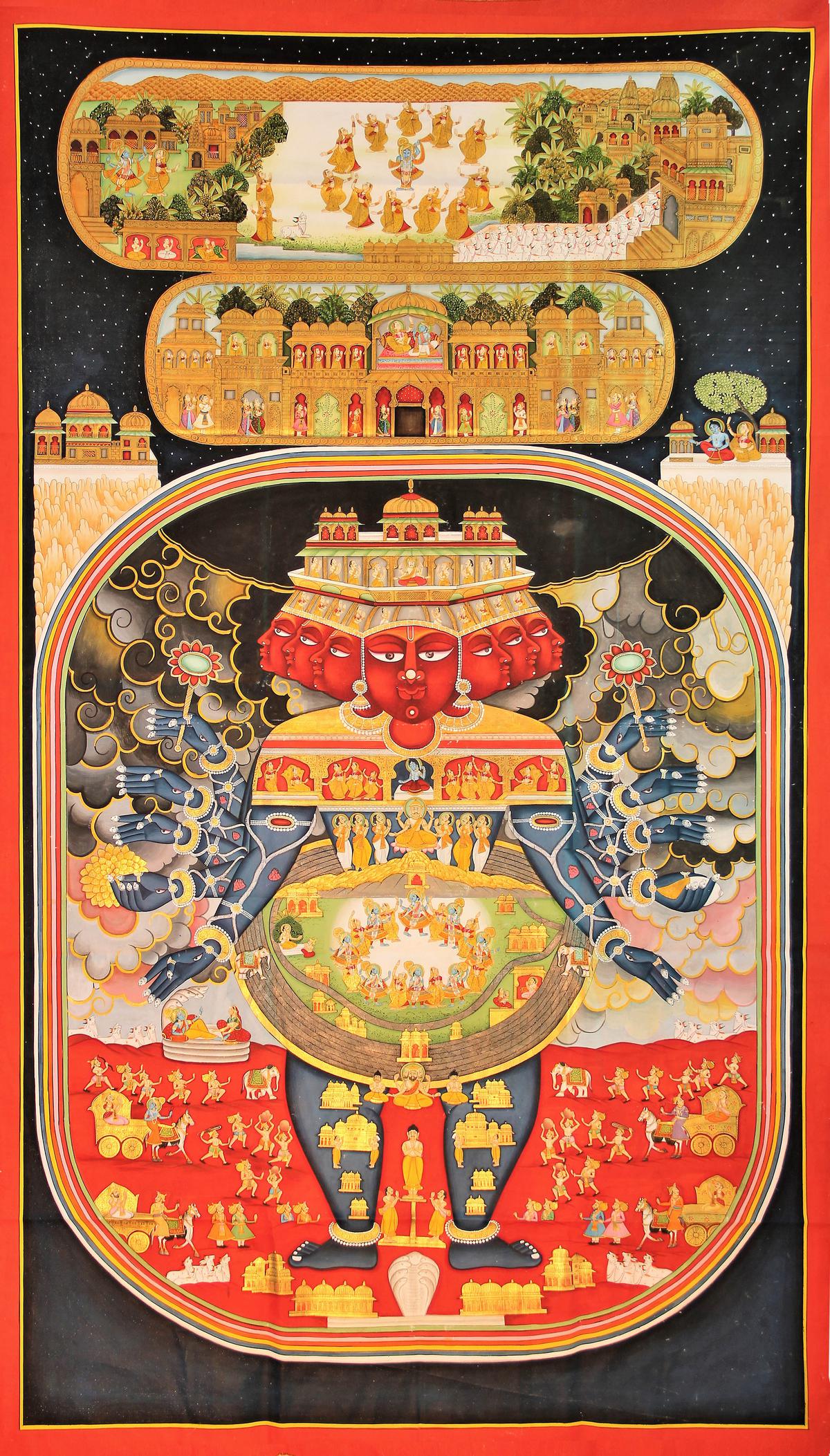Rainbow, an exhibition of paintings in the Pichwai tradition by Yugadeepak Soni, transcends the realms of imagination, culture and skill
Rainbow, an exhibition of paintings in the Pichwai tradition by Yugadeepak Soni, transcends the realms of imagination, culture and skill
In the late 16th century, the land bordering Mewar was a wild country inhabited by warring tribesmen and weary travelers on the old caravan routes that circled the Thar Desert. But its heart, a few hundred miles to the south, was filled with lakes, and the colorless landscape where only the acacia survived gave way to lush valleys, forests, and ancient wells where oxen drew water.
Here, now in the Rajsamand district, Nathdwara was home to the Shrinathji Temple, a pilgrimage center for Vaishnavas and the birthplace of the Pichwai tradition of painting. The paintings, mainly of Krishna with large eyes and a stocky construction, earned their name because they were hung behind the deity ( peach-behind, so– hang). Over four centuries, Pichwai has covered various themes – Raas Leela, Jain folklore, the cult of Hindu gods, the Hanuman Chalisa, Views of court life, and local flora and fauna – although it is Shrinathji in the form of a cowherd, holding the Govardhan mountain, and visible to his devotees that still prevails.
Yugdeepak Soni at Pichwai Workshop | photo credit: special arrangement
In a workshop as part of Rainbow, an exhibition of Pichwai paintings, artist Yugdeepak Soni traverses the cultural distance of this art form, as he draws the outline of a woman on a sheet of handmade paper rubbed with onyx. The figure is characteristic of the Mewar school, drawn in profile with almond-shaped eyes and a sharp nose. Soni fills in the colors of her skirt and bodice line by line, using a fine-tipped brush, with the ease of practice of a painter who has spent years mastering the look.

A Pichwai painting by Yugdeepak Soni, the Virat form of Lord Vishnu. photo credit: special arrangement
“I was introduced to Pichwai when I dropped out of school. I packed for Bhilwara for a few years at my maternal uncle’s house, having learned from my great-grandfather, the famous Badri Lal painter. I felt at home with brushes, learning how to make pigments, techniques, how to play with colors, getting inspiration and most importantly feeling happy pursuing it. If there is happiness within you, colors will find you,” says Soni, who now lives in Udaipur. “I’ve been painting for two decades, but I’m still learning. Mistakes happen in concept and scale of work because a work takes months. Reading folktales, mythology, and watching cultural events take the art forward. Helps to enhance, although some of the inspiration for applying the style comes from previous works.”
Painted mainly on cotton cloth, muslin or handmade paper, over time, Pichwai moved from temples to grand drawing rooms and melody-make-up (music, food and ornaments for the deity) Format for homespun vignettes from rural Rajasthan. The exhibit showcases 55 of Sony’s works, some painted during the pandemic, with an array of brushes and paint. “For the eyes and brows, a single-hair squirrel tail brush is used, while a brush made from mongoose hair is used for thick lines,” says Soni, adding that she exclusively uses indigo , metallic and mineral paints and use gold foil. Implementing Mughal and Rajput styles.
The paintings are in a variety of sizes, the fabric panels are larger, and the elements on the paper are more crowded. Banana trees hold themselves in a sea of other trees, peacocks swirl as grayish-blue-white monsoon clouds curl up in an indigo sky, cows swirl through the landscape and well It also outlines defined boundaries as women dance like a dream with intensity.
The hanging display allows the viewer to engage with the painting and see the details of the artist’s firm hand. Colors that are ripe and round are filled only with geometric precision. fillers, such as thirty sixBoats, lotuses and gardens are scattered in contrasting places in keeping with the theme.
Soni says that he prefers to work during the day as colors are best seen in the sun. The canvases that stand out include the Krishna Leela, filled with row of dancers in homosexual abandon, which has Krishna center-stage, and Gopashtami, with cows gazing at Shrinathji. a giant cosmic Vishnu in midnight-blue, filled with mythological scenes, Soni’s favorite (festival) in which women are seated on leaf pads around Shrinathji on lotuses and cows; Elephants wrestle with their trunks locked in embrace, the gold on their chains shines in the light of the gallery; And the festival of Gangaur, women looking out from lattice-screen windows, as a parade of boats full of men in hot pink turbans pay homage to the Maharana, are a few that stand out.
Each of these frames encompasses a world that alternates between the spiritual and the cultural, much like Mewar’s myriad landscapes.
The exhibition is open from Monday to Saturday, 10.30 am to 6.30 pm at Forum Art Gallery, 57, 5th Street Padmanabha Nagar, Adyar till 8 April. For more information, call on 8778726960.